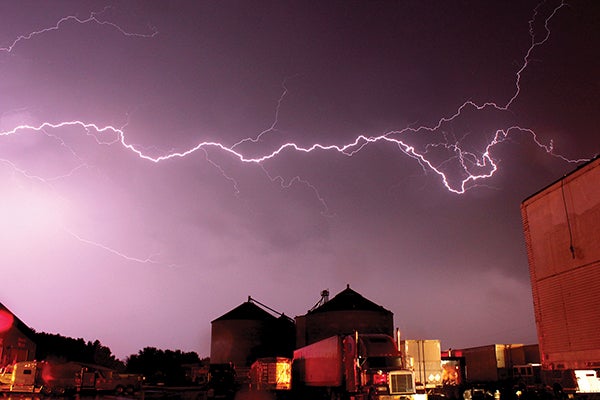Rain closing an already tight window
Published 5:01 pm Sunday, June 9, 2013

Lightning fills the sky above grain bins in Racine during an intense storm that brought high winds and torrential downpours on Friday, May 31. Record rainfall this year continues to prevent farmers from getting into their fields.
Matt Peterson/matt.peterson@austindailyherald.com
Corey Hansen slipped his tractor into a saturated field near Austin Friday and planted beans — for the first time this year. For him, planting corn is now out of the question.
“I think the only people that are really sticking to corn are the guys that need it for forage,” Hansen said on the phone Friday while pressed for time, trying to squeeze as many beans in the ground as possible before the 2013 planting window closes even tighter. Hansen planted about 50 percent of his corn for the year and switched to beans, like many area farmers. He’ll likely have some unplanted acres, but at least he had some decent weather for planting over the weekend. Still, the forecast calls for more rain, nearly every day through the next week, except for next Tuesday.
“I will plant beans to the Fourth of July if I have to,” he added.
Near Blooming Prairie, Jim O’Connor started planting beans more than a week ago, just before a massive storm and four-hour lightning show passed over the area. He wasn’t sure if he’d have any unplanted acres. He hoped not. It would be like leaving blank pages in the newspaper, he said.
“I’m sure hoping not,” O’Connor said about having empty fields. “That’s not why I got into this occupation.”
This year’s dire southeastern Minnesota planting situation has stirred a lot of talk about crop insurance. It will be a saving grace for many.
“You’re just better off letting it sit and taking the insurance money,” Hansen said about some farmers leaving fields unplanted, depending on how much insurance coverage they have.
According to Joe VanHooser, a local insurer, farmers can get up to 85 percent coverage of their 10-year average yield on planted acres. However, that number drops 1 percent every day a farmer plants after May 31 and drops further after late June.
When a farmer chooses not to plant a field, which is called prevented planting, he can recover 60 percent of his overall coverage rate.
While some people talk about farmers cashing in on crop insurance, farmers and insurers say that’s not the case. Farmers would rather have a bumper crop than 85 percent of their average yield, and they’d much rather have a planted field instead of redeeming 60 percent of their 85-percent coverage. For farmers who don’t buy as much coverage, the situation is worse. Furthermore, farmers and insurers point to input costs, such as rent, fertilizer, fuel and hired help. For those who don’t plant fields, that money is down the drain, along with some of the record rainfall for the year, while more water still sits on the topsoil.
As of June 7, the Austin area had received 22.1 inches of rainfall, just shy of 2012’s total of 22.19. Mother Nature will outdo that number soon.
“Probably any rain we get tonight or tomorrow will take care of that,” NWS meteorologist Zack Taylor said on Saturday.
Austin caught the most rain of all time in May this year with 10.98 inches, 2.55 inches greater than the previous record in 2004 and nearly half of last year’s total.
Despite the soggy mess, gutsy farmers like Hansen went out during the weekend and did what they could. At least the topsoil was dry in some areas, Hansen said, who hung up the phone, turned his tractor around and made another pass.
After all, Sunday night’s forecast called for scattered showers.
Let it rain
Below is a list of significant rainfall numbers and how they stack up about midway through 2013
2012 total: 22.19 inches
Year to date through June 7
•2013: 22.1 inches (record)
•1945: 19.29 inches (2nd)
•2001: 18.4 inches (3rd)
May 2013: 10.98 (record)
May 2004: 8.43 (2nd)
May 2000: 7.69 (3rd)




